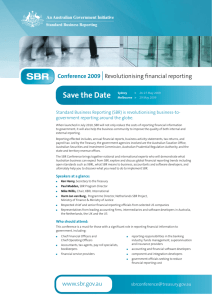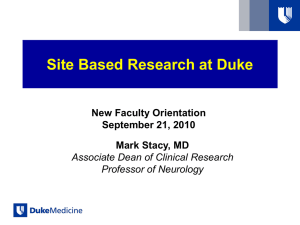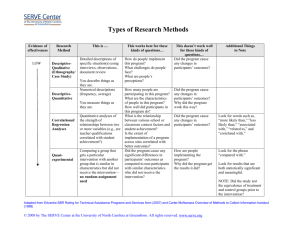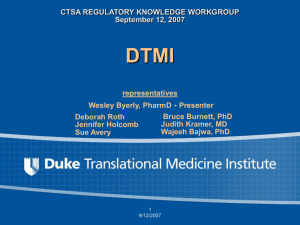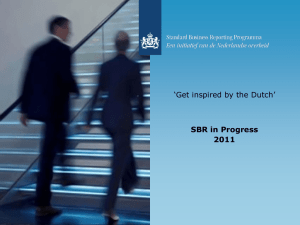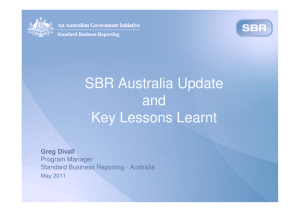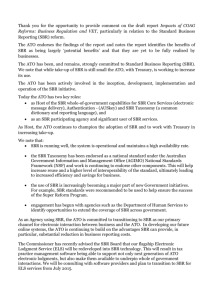1. SBR Overview
advertisement
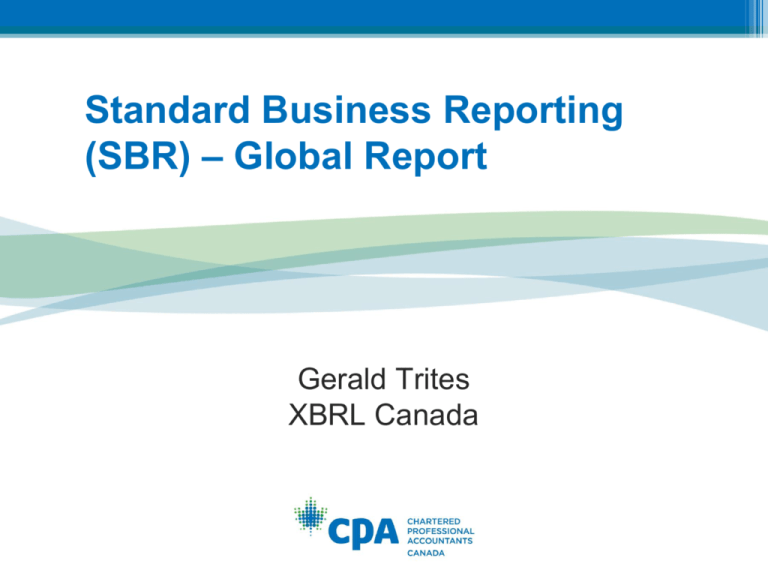
Standard Business Reporting (SBR) – Global Report Gerald Trites XBRL Canada 1 Introduction CPA Canada has recommended the Standard Business Reporting (SBR) model to the Government in pre-budget consultations in the past three years The House of Commons Standing Committee on Finance picked up this recommendation in its annual report 2 Introduction The use of SBR is particularly useful for cutting the cost of compliance incurred by business It is also consistent with the Open Data Initiative of which the government is a part 3 SBR Overview Standard Business Reporting (SBR) is a group of international initiatives based on XBRL and designed to reduce the business-to-government reporting burden Started in The Netherlands in 2003, SBR was then adopted in Australia in 2006 and is currently being considered by many other countries including China, Brazil, UK, Belgium Key features: ▫ ▫ ▫ ▫ Cross-government Multi-agency and platform independent Streamlines Multiple reports Standards, including but not limited to XBRL, are enablers Key focus: costs reduction for businesses 4 XBRL Adoption Around the World G20 • • • • Outside the G20 Argentina Japan (SBR) United Arab Emirates Netherlands (SBR)(Audit) Australia (SBR) Mexico (SBR) Belgium (SBR) Poland Brazil (SBR) Russia Bermuda Romania China (SBR) (Audit) Saudi Arabia Denmark (Audit) Singapore (SBR) France South Africa Hong Kong Thailand (SBR) Germany Korea Ireland Taiwan (SBR) India (SBR) (Audit) Turkey Israel Spain Indonesia United Kingdom (SBR) Luxembourg Sweden Ireland United States Malaysia (SBR) Switzerland Italy European Union Finland BOLD: XBRL mandate(s) in production Audit – Program in place to require independent assurance over XBRL submissions. GREEN – In Development with a voluntary program SBR –“Standard Business Reporting” burden reduction effort converging disparate agencies compliance processes via IFRS XBRL Taxonomy. 5 SBR Overview Streamline business-to-government reporting through SBR-enabled accounting/payroll software Using SBR-enabled software will allow businesses to prepare and lodge key government forms directly from their software to SBR partner agencies Single credentials – such as AUSKey in Australia More information: www.sbr.gov.au and www.sbr-nl.nl 6 Primary Aims of SBR – Where the Savings Are Use of standards to reduce cost to business Single language to report to government Harmonisation and reduction of reported data – 98% and 70%!!! Ability to attach meaning to business and financial data Reporting data becomes a by-product of normal business record keeping/accounting processes Have reports pre-filled in business software As far as possible – automate the reporting process 7 Scope of Existing SBR Programs The Netherlands ▫ 3 agencies ▫ 1.5 million businesses ▫ Reporting elements reduced from 200,000 to 4,500 (-98%) Australia ▫ 12 agencies ▫ 2.1 million businesses ▫ Reporting elements reduced from 9,648 to 2,838 (-71%) 8 Australian SBR Program Went live in July 2010 Cost: AUD 170M The Commisioner of Taxation reported in his annual report for 2014-15 that SBR use exceeded 15 million transactions for the first time, with estimated savings to business using SBR-enabled software of $400 million. 9 Basic Components of SBR COMMON LANGUAGE DefinitionalTaxonomy STANDARDIZED FORMAT Business Software REGISTRATION AND ASSERTION AUTHENTICATION TOKEN Messaging Infrastructure Core Services Web services STANDARDIZED CONTENT Web services ReportingTaxonomies Government Agency Authentication AUSkey 10 Taxonomy The SBR taxonomy has two main layers ▫ Definitional taxonomy ▫ Reporting taxonomies Definitional – Dictionary of agreed terms that comprise the common language Reporting – Structures for the exchange of data that use the terms defined in the Dictionary 11 How the SBR Taxonomy Architecture Works Definitional Taxonomy – Common Dictionary Define the concept once… Information Classification B Information Classification A A.1 B.1 A.2 B.2 Address … Wages & Salaries … re-use on many reports Reporting Taxonomies Agency X Agency Y Agency … Report X.1 Report Y.1 Report X.2 Report Y.2 12 Benefits of the SBR Taxonomy Architecture Each SBR Program develops its own taxonomy, but they have the option to leverage the SBR Taxonomy Architecture used in most Programs – which saves time and resources It is also an important governance tool and it facilitates harmonization 13 Conclusions SBR is a global reality Existing Programs are having a significant impact ▫ Costs reductions ▫ Rationalization and simplification New Programs are leveraging best practices and lessons learned and achieve results more quickly and with lower investment SBR in Canada has the potential to significantly reduce compliance costs for businesses 14 THANK YOU 15
